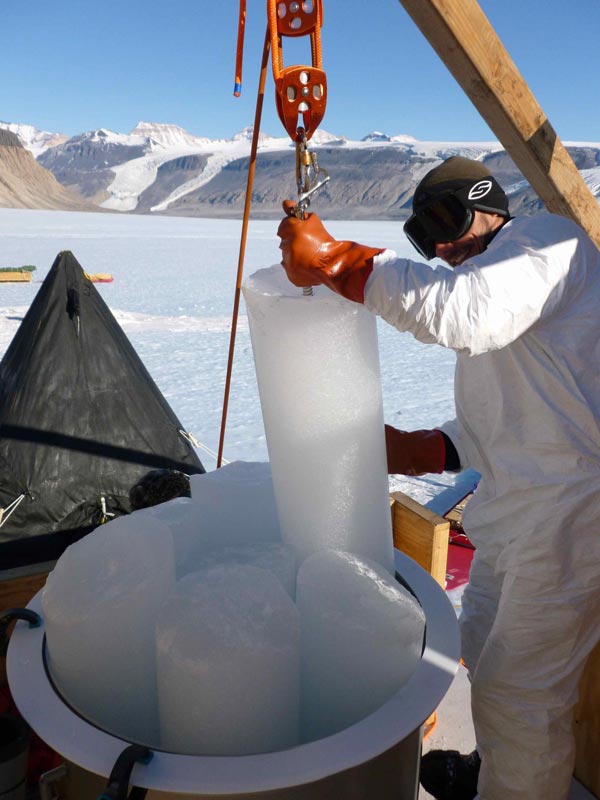

This is Vasilii Petrenko loading an ice core into the melting chamber for extraction of trapped ancient air.
Credit: Xavier Fain
In a new paper published in Nature, the researchers report two important findings regarding methane, a powerful greenhouse gas and large contributor to global warming:
- First, the risk that warming will trigger methane release from large natural reservoirs of ancient carbon seems to be low.
- Second, humans are probably contributing more methane to the atmosphere through fossil fuel use and extraction than scientists previously believed.
Reducing methane emissions from fossil fuels may therefore be an even more important factor in reducing global warming.
“Our results are suggesting that anthropogenic (man-made) fossil fuel methane emissions are even larger than previously thought,” Petrenko says. “This means we have even more leverage to fight global warming by curbing methane emissions from our fossil fuel use.”
Today's atmosphere contains methane that is emitted naturally — from wetlands, wildfires, or ocean and land seeps — and methane emitted from human activities like fossil fuel extraction and use, raising livestock, and generating landfills, with human-emitted methane accounting for 60 percent or more of the total.
Scientists are able to accurately measure the total methane level in the atmosphere and how this has changed over the last few decades.
The challenge? Breaking down this total into the specific sources.
“We know rather little about how much methane comes from different sources and how these have been changing in response to industrial and agricultural activities or because of climate events like droughts,” says Hinrich Schaefer, an atmospheric scientist at the National Institute of Water and Atmospheric Research (NIWA) in New Zealand, where a key part of the sample processing took place. “That makes it hard to understand which sources we should target specifically to reduce methane levels.”
Scientists can use measurements of different isotopes of methane (methane molecules with atoms of slightly different mass) to fingerprint some of the sources. But even this approach doesn't always work because the isotope “signatures” of some sources can be very similar. For instance, fossil methane is methane emitted from ancient hydrocarbon deposits, typically found at sites rich in fossil fuels. Fossil methane that leaks naturally from these sites–“geologic methane”–has an isotope signature that is identical to fossil methane emitted when humans drill gas wells.
Separating the natural and anthropogenic sources and estimating how much humans emit has therefore proven difficult.
In order to better understand the natural and anthropogenic components of fossil methane, Petrenko and his team turned to the past.
As part of the University of Rochester's Department of Earth and Environmental Sciences and the Center for Energy and the Environment, Petrenko's lab is dedicated to understanding how both natural and man-made greenhouse gases respond to climate change. They analyze how past climate changes have affected greenhouse gases over time and the ways in which these gases might respond to future warming temperatures.
In this case, Petrenko and collaborators from several US and international laboratories, with support from the National Science Foundation, studied past atmospheric records using ice cores extracted from Taylor Glacier in Antarctica. These cores date back nearly 12,000 years.
Every year that it snows in Antarctica, the current snow layer weighs on the previous layer, compacting over hundreds or thousands of years to eventually form layers of ice. These ice layers contain air bubbles, which are like tiny time capsules; using vacuum pumps and melting chambers, researchers are able to extract the ancient air contained within these bubbles and study the chemical compositions of the ancient atmosphere.
Humans did not begin using fossil fuels as a primary energy source until the Industrial Revolution in the 18th century. Because of this, 12,000-year-old ice cores contain no fossil methane originating from human activities; fossil methane levels are based solely on methane emitted from natural sources. Natural geologic methane emissions of the past are thought to be comparable to natural emissions today, so studying ice cores allows researchers to very accurately measure these levels, separate from their anthropogenic counterparts.
“Going back before any anthropogenic activities–before the Industrial Revolution — simplifies the picture and allows us to estimate natural geologic sources very accurately,” Petrenko says.
The natural geologic methane levels the research team measured were three to four times lower than previously estimated numbers. If the natural geologic methane emissions are lower than expected, the anthropogenic fossil methane emissions must be higher than expected–Petrenko estimates by 25 percent or more.
The study also suggests that the risk of methane release from natural ancient carbon reservoirs is lower than previously thought. Scientists have raised the possibility that global warming could release methane from very large ancient carbon reservoirs such as permafrost and gas hydrates–ice-like forms of methane in the sediments at the bottom of the ocean. These become less stable as temperatures increase. If climate change from burning fossil fuels were to trigger large emissions of methane to the atmosphere from these old carbon reservoirs, this would lead to even more warming.
“The ancient air samples reveal that these kinds of scenarios regarding natural methane emissions are not as important to take into account for future planning,” Petrenko says. “In contrast, anthropogenic fossil fuel emissions seem to be even larger than we previously thought so reducing these levels has more leverage to mitigate global warming.”















